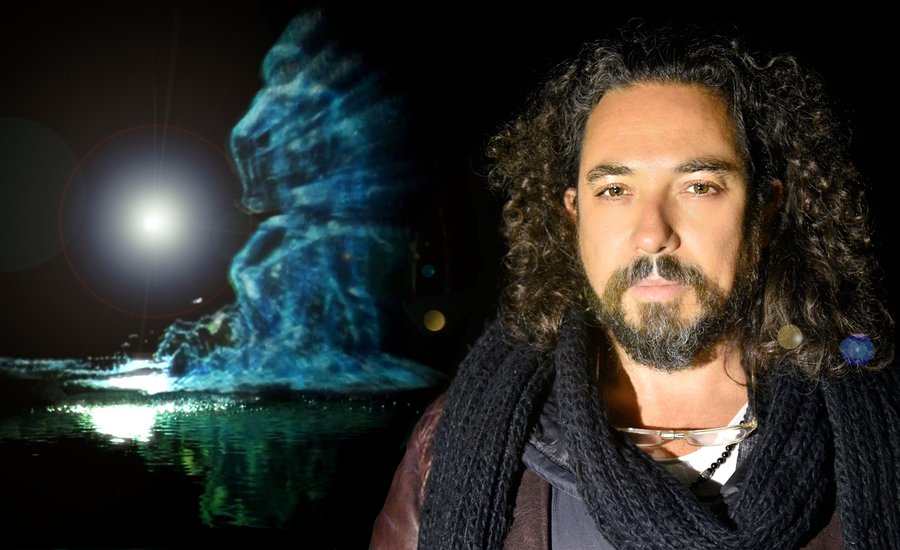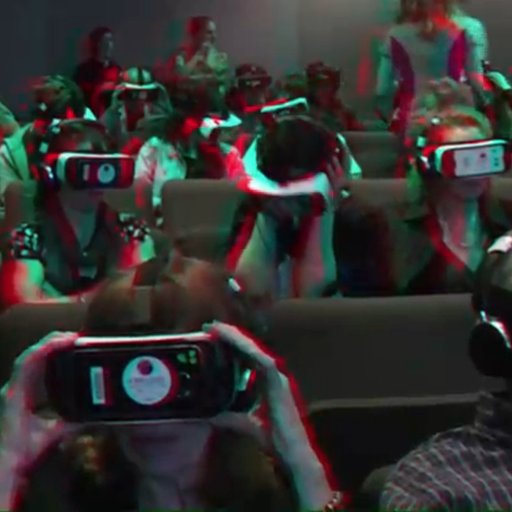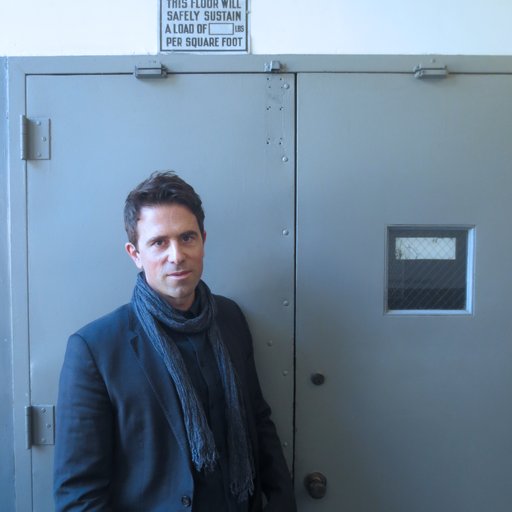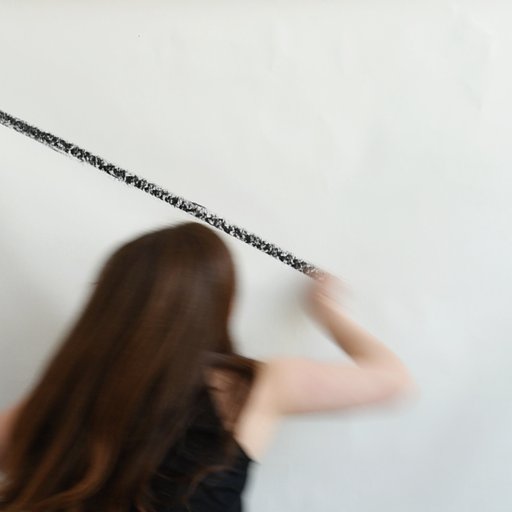How’s this for a site-specific installation? This coming February, if all goes according to plan, the International Space Station will “exhibit” the first-ever artwork created in outer space: a sculpture produced out of a collaboration between NASA , the zero-gravity 3D-printing company Made in Space , and the Israeli entrepreneur-turned-artist Eyal Gever . The piece will take the form of a 3D-printed rendering of a single peal of human laughter, selected via Gever’s just-launched smartphone application that allows users to upload and vote on their favorite giggles, chortles, guffaws, and snickers.
If all this seems a bit unusual—the involvement of science and industry, the crowdsourcing app, the sound-visualization-sculpture—it’s because Gever is not your typical artist. Long before NASA tapped him to help design humanity’s first extraterrestrial artwork, he was riding high on the waves of the dot-com boom as the founder of the graphics companies Gizmoz and Daz3D, among other startups. Gever turned to art full-time in 2010, churning out novel programs and technologies that turn digital models of split-second events like explosions, car crashes, and tidal waves into large-scale sculptures. It’s precisely these tech-meets-art bona fides that made him particularly attractive for this unusual commission, and Gever is positively exuberant about the project and its implications.
In a conversation with Artspace’s Dylan Kerr , the Tel Aviv-based artist was prone to rhapsodic asides on the power of art and technology as well as passionate critiques of the art-world establishment, which has been slow to embrace his decidedly futuristic outlook. Here, Gever discusses his circuitous route to making art history, the strange technical issues that arise when fabricating art in the vacuum of space, and why the gallery model may soon go the way of the telegraph . To add your own chuckle as a candidate for interstellar immortalization, download the #Laugh app here .
Before you embarked on your artistic career, you were a successful entrepreneur in the technology sector. How did you make this transition?
For me, art has always been the only field that made me feel connected, and like I have a reason to be here. It’s the only thing that I can totally understand, love, and be passionate about 24/7.
When I studied art in high school and university, I learned the history of art and composition and sculpture and color—all the basics, and much more. After that, I was in the army for two and a half years as a special operations combat soldier. I eventually got injured, and I had to rest. When you're in one of those crazy units, you live in a time capsule. Your time is in seconds. Every second you are being told what to do, and all of a sudden I was sick of it. I couldn’t stand it. I volunteered to move elsewhere.
The Israeli army has a very, very advanced computer force. Because of my experience and grades, I could choose wherever I wanted to go, so I chose a very unique new group that specialized in simulations. Before then, I had been making paintings that were three or four meters across in the pointillist style. It used to take me three, four, five months to finish a painting. I used to immerse myself in painting, but because I was injured I found the same OCD concentration on the monitor, with pixels.
I was exposed to computer simulations back then, but when I finished my time in the army I immediately went to study art in the Bezalel, which is the leading art and design academy in Israel. However, I was one of the first artists in the country to know anything about computer graphics and simulation. Up until that point, we only had one TV channel—the government channel. Then, in ’91, commercial TV and cable came in all at once. A huge industry was founded, and they needed people who knew computer simulation. I was one of the only ones.
While I was an art student, I used to freelance and do projects for these companies. Then, all of the sudden, the companies started to grow. At the same time, I was so disappointed with the academic, old-fashioned view of things at the art academy, in part because there was this highway to a new renaissance. I saw the future, and left the academy to start my own company.
My company grew so fast. By the second year I had 30 or 40 employees—it just took off. I found that I was learning much more, and that the renaissance was gathering in Silicon Valley. This is what attracted me. I entered this 18-year rollercoaster of building companies to push new technologies that relate in some way to visual communication, often in 3D and animation. It could be for computer games, it could be for social advertising, special effects, et cetera.
Art was always burning inside me, but I didn’t feel I was ready to become an artist—this is also why I left the academy. I hated it. I was totally confused about how they see art. There are artists who achieve success and relevance quickly, like Damien Hirst or Basquiat . There are artists who are late bloomers, who might take 20 years to be ready, like Marcel Duchamp . For me, it took 20 years.
The key story is that in 2001 I was about to sell my company for a lot of money, around $180 million, and then, in the matter of a quarter, the market started to crash. Not too long after that, September 11 th happened. Even though my company survived—I was eventually able to rebuild it and sell it—it brought me to the point at which I realized, "I don’t have control of my life. I don’t have control of the future." Everything that I had created in my twenties was software, and by the time September 11 th happened I was 30. I realized that if the company died, all of my creations would fade out, because if you don’t maintain the software or the servers they will cease to exist.
An artist creates tangible pieces, whether it’s a music piece, a movie, a sculpture, or a painting. I said to myself, “Even though you have a responsibility to save your company now, you must start to devote 10, 20, 30 percent of your time to art, so that when the day comes and you’re free, you will have a place to start. You owe it to yourself to one day fully commit to art.” That was 2001.
 Big Smoke
, 2012 (right)
Big Smoke
, 2012 (right)
Once you made the decision to prioritize your creative impulses, how did you make the shift towards finding your voice and actually making art?
It took me nine years to build my own lingo and philosophy, and as well as create the coding tools I needed. I set a few rules for myself. One rule was that the world does not need another painter or another traditional sculptor or photographer. What’s unique about me is my deep understanding of art and the history of art, and also my left-brain/right-brain ability to feel totally comfortable in those two worlds, whether it’s very logical, technical problems or very abstract, creative, artistic questions.
I decided that the second rule was that the palette would be code, and the output would be tangible objects made with 3D printers. They are physical sculptures, but I need to create things that can only be produced and manufactured with a 3D printer, because otherwise why would I bother? I could just use clay or marble.
I decided that I was going to create simulations that we as humans are not used to experiencing. It’s almost as if I created my own high-speed camera, where I am inviting you to enter explosions, or tsunamis crashing, or car accidents, or music, or dance. I can freeze a moment that I think is the pinnacle moment and print it as a sculpture. The sculpture is being born only in the moment where the viewer is next to it, in the tension between your body and the size of the sculpture. When you look at a sculpture, you feel that this time is frozen. This became the second rule.
The third rule is about the aesthetics that I employ, which are very reserved and minimal. When I do a simulation, I can treat nuclear explosions or car crashes as a serial killer or a surgeon would—I don’t get emotional. I show it to you in a very ascetic way. If it’s an accident, I don’t need to show you the blood. You, your brain, will supply the story when you look at it—the physics simulation is that accurate. It’s about conveying the strength, the force, of the moment.
Even after I set these rules, the tools weren’t there. I had to develop my own code. Three-dimensional printing was in its early stages, and having been an entrepreneur in technology I was used to thinking about things that have never existed before. I was used to thinking about going out to find the best brains and make it happen. That was kind of the same here. It just happens that it took me 10 years to master these tools and create my own language.
I think spending 20 years on this cutting edge of technology allowed me to master these tools, but I’m not in love with the technology or the tools themselves. I am obsessed with the meaning of my art. When you look at new art, many times you see either technical people who are trying to do art—which often doesn’t work—or you see artists who are getting exposed to new tools, which often leads to over-filtered, Photoshopped, gimmicky artworks. It takes awhile for people to get in control of their new tools and then create a language from that. It was certainly a journey for me.
Turing to the project at hand, how did you get the opportunity to be the first artist to create a work of art in outer space?
I was actually approached by NASA and Made in Space, which is a group that is responsible for the development of the zero-gravity 3D printer. They heard about my work, and they told me that NASA’s goal over the next 10 or 20 years is to become totally self-sufficient in space, with the ability to fabricate the stuff they need up there. Basically, they want to be able to detach themselves from Earth, and the first step towards doing that is building a zero-gravity printer. They said that art and culture are important to them as an international group, and they asked me if I’d want to do the first sculpture in space. I said, “Of course I do,” and that’s where it started. It was an intensive process of figuring out what it means to work with zero gravity, to make a sculpture that can function in space, and to consider the implications that go along with that. I wanted to work with subject matter that goes with my research, as an artist that also has an international appeal and point of view.
How did you settle on laughter as the universal marker of humanity?
Initially, I was thinking about doing a sculpture that can exist only in zero gravity. My idea was to design a structure that, when printed in space, would be taken outside of the space shuttle by an astronaut and become like Pong, the first computer game—two rows that are colliding with the ball.
My other early idea was something with a more human approach. I’ve been developing my next generation of artworks for the last two or three years, and a big part of that is simulating music and sound. I thought if I approached somebody that humanity really respects, like Nelson Mandela, and asked him to say something inspiring, I could simulate his voice and print it as a sculpture in space.
Two weeks later, he passed away. That experience made me realize that I may need to think about something that is not related to a particular country, or race, or politics, or language, but rather something really universal. Something that gets at the human core.
Laughing can mean multiple things. It doesn’t necessarily mean joy—it can be sarcastic, it can be angry, it can be nervous. There are multiple ways to laugh. It’s also unique to humans versus other animals. This is how it all started.
Is this the idea behind your app, which essentially crowdsources the process of selecting the laugh?
When I decided I wanted to go for laughter, I didn’t want to be the one who chooses which laugh to send to space—it just didn’t make sense to me. I wanted it to be an output of the social wisdom of the crowd. I wanted to let humanity choose based on… who knows, right? [Laughs].
I said, “Okay, so what’s the interface? How will people laugh?” We decided to do an app. When people download it they get an explanation about the project, they’ll see laughter that will hopefully trigger them to laugh, and they’ll be able to record their laughter or their friends’ laughter.
I’ve been working with an amazing team from AutoDesk, a leading 3D software company, on developing a very, very ambitious 3-D sound visualizer. When you laugh, there are many 3D visual interpretations that I am creating for the app, each one mathematically accurate. After it analyzes the sound of your laughter, you can copy and send it to friends.
The idea is that the laughter that makes the most people around the world laugh themselves—in other words, receive a "like"—probably deserves to represent humanity. That laughter will be sent to space. Every laugh that is uploaded can be shared, sent, and visualized as a 3D space sculpture. Later, people will be able to purchase different laughs through the app.
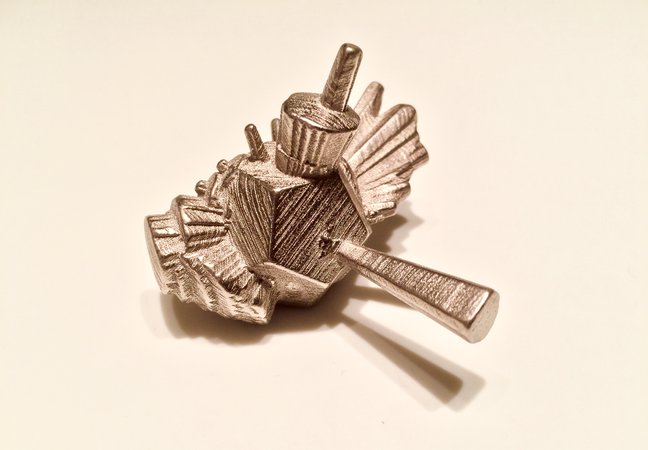 A 3-D printed
#Laugh
rendering, 2016
A 3-D printed
#Laugh
rendering, 2016
What’s your vision for the sculpture itself?
My goal for the sculpture is that it will stay in space. We will print an Earth version, but the unique sculpture that humanity chose will stay in space. In my view, this has the potential to be an iconic image of human creativity, like cave paintings—something that says, “Here I am, I exist.” I think the image of humanity’s voice encapsulated in space is a powerful idea.
I believe this is not just an art project—it’s almost a milestone. Every generation has different markers. In our case, the most fundamental thing that we are trying to cope with is society and humanity. The insanity, the overload, the speed, the progress and the change—there are no borders due to technology and the tools. Living on Earth, I’m constantly toggling between how primitive and crazy humanity is on the one hand and how advanced and unbelievable, almost science-fiction-esque we are on the other.
I will take my time, but I think the sculpture should eventually be auctioned. I want the piece to reflect back onto our culture and the art world. Having a sculpture in space and offering it to art collectors later on in the game could be a reflection on what buying and collecting art means in the 21 st century.
Can you tell me a little bit about how this project works on a technical level? How do you go from a sound recording to a 3D-printed, physical sculpture?
The sound I’m analyzing is based on a spectrogram . I can mathematically analyze the sound in real time and then figure out how I want the physical shape to appear within the parameters of the sound. The options are very rich and wide. At the end, there’s a file format I export. My goal is not to export a moment of the laugh, but rather from the time the laughter starts until the end. When future humans or some kind of extraterrestrial finds this—don’t laugh at me, but I do believe that there may be some alternative intelligence out there, just based on the sheer number of stars—and if mathematics is indeed the universal language, they should have some way of parsing or understanding this data.
What about the physical printing of the sculpture?
The material is still confidential—I’m not allowed to say what it’s made of. It will print in the space shuttle. I’m not sure how familiar you are with 3D printing, but these guys have created some very smart technologies that consume very little energy without releasing gas into the space station. They found a way to print and solidify materials in zero gravity, and the material can exist in space conditions—pretty fucking cool [laughs].
Are these technologies that you developed for this applicable to earthbound 3D printing as well? Are they raising the bar for 3D printing across the board?
Totally. The output is the visualizer or the engine that I created. You can export file formats that any 3D printer supports. Any mathematical description format, I can export. It doesn’t matter for this program. The tool is very, very powerful.
Is NASA using this project as a kind of proof of concept to test out the viability of manufacturing other, perhaps more useful items in space?
Of course, if you push yourself to create a piece of art, the only thing a piece of art is striving to be is a masterpiece. That means you have to create something that doesn’t have any compromises. In that regard, yes, I do believe that if they’re able to accomplish something like this with somebody as demanding as I am, it could be a milestone for them.
In essence, though, it’s not quite so momentous. NASA is doing many other kinds of tests on this technology. If you ask me, my project is more than a technical adventure. As a global brand, NASA puts a lot of effort into education, from STEM subjects to more cultural topics, and this is one way to intelligently incorporate art.
What is art? Art is the story of humanity. If you run through history, different forms of art are kind of the pinnacle moments of the years that pass by. You see humanity in its glory. I believe that in the next hundred years, space is going to be the new frontier. Given the exponential growth and evolution of technology and industry over the last hundred years, space is going to be much more within our reach 20, 30, 40, 50 years from now. Making art in space is pushing and expanding the envelop of humanity and creativity, but it’s just another medium. Whether it’s photography, or video, or digital art, artists always apply or learn to use new tools and try to work in different places. This is the time when I’m alive, so I guess it’s my turn. Why not space?
 More examples of printed
#Laugh
renderings, 2016
More examples of printed
#Laugh
renderings, 2016
This won’t be the first time we’ve launched artistic artifacts into space. I’m thinking of Carl Sagan's work on the Voyager Golden Records , but also Trevor Paglen’s Last Pictures project, where he put images on a satellite that will orbit Earth until the sun explodes. Do you think at all about your precursors?
I do, mostly to know what came before me and what those people were doing or thinking about, but that’s where it stops for me.
My work is not about documenting humanity or sending a message in bottle to space, like those previous art pieces were. I think what’s very, very powerful about my work is that it’s a pipe between living, breathing humans through social networks. It’s not a memorial. I’m giving people a channel to literally create in space—it’s almost like an active project. Even the three or four months that the app will run will capture three or four months of humanity.
I think about Andy Warhol when he started to use silk printing, the same technique that was used in newspapers. This project is applying a similar approach, in the sense that these over connected, 24/7, propagated, viral social networks are our contemporary mass media—we can’t live without it, but it’s a love-hate relationship. This is the material that 21 st -century artists have to work with, our silk screens.
My palette is code, so I’m refining my craft and building my tools and I’m attracting the best brains in the world to join my crazy project. Together, we are really creating new kinds of brushes, if you will, that have never existed before. It’s not just that I’m building my own brushes—I’m figuring out how to use those brushes to execute my meaning. It’s all about the meaning of the art, not about the tool or the technology. It’s as if I’m inventing, with a team of other people, my own marble and the tools that enable me to sculpt it. This marble isn’t stone anymore—it’s social networks, code, communication. This is the 21 st century.
We’re living in a time when entirely digital artworks are increasingly becoming accepted as bona fide works of art, so it’s interesting that you are so intent on bringing these things into the physical world. What is it about this process of interpretation and translation that appeals to you as an artist?
I see myself as a sculptor more than a painter. Richard Serra says that his sculptures are born only when the viewer is standing next to those huge metal objects. For me, it’s fine that you can enjoy the simulation on the screen. The simulation is a vital part of the creation—it is the creation. That said, having tangible objects that are playing with your understanding of what’s real and what’s not forces you to ask questions like, “Are we living in a computer simulation?” or more simply, “What the fuck is going on around here?” All the information that you are consuming is being manipulated. The news is manipulated, images are manipulated—everything is already simulated, and this is just the freaking beginning.
When I show you a piece of ocean simulation, it definitely looks like an ocean—but I’m cropping it. I’m not trying to convince you that this is better than reality, that this is real. No, I’m cropping it like you crop a photo in Photoshop, or like a piece of cake that you cut from the sheet. This is a piece of ocean. When you look at this area and the ocean animation is moving, you feel the sheer strength of the ocean, but when it’s printed as a physical sculpture it has the energy of the ocean while still being an object in space. This is a big part of what challenges me—what's the border between real and not real anymore?
Painters used to make portraits of important people, or nature, or the different periods in history or religion—the vital issues of the day. I think the important subject matter of our time is the border of yin yang, of what's real and what's not real, what is soft and what is hard, what is tangible and what is not. Moving between those borders is sort of what I do.
 Waterfall
, 2014
Waterfall
, 2014
As someone who’s interested in art that utilizes the cutting-edge technology of our time, one huge disappointment for me is the amount of artists who seem content with merely instrumentalizing these amazing tools—who make art that says, “Look, I made this with a 3D printer. Isn’t that neat?” On the other hand, you mentioned that you think about these technologies as a new kind of paintbrush that lets you make artworks that can reflect on more than just the means used to create them.
Totally. People don't necessarily need to know what the tool is that brought me there. The criteria that I'm concerned with are aesthetics—composition, colors, rhythm, tempo, shape, mass. Those are elements that artists have dealt with since the beginning. The tools just are a means to an end.
Many times, my use of tools starts where other people finish. That's why most times I’m not satisfied with what I see out there. I have to create my own because it doesn't have the capabilities that I’m looking for, especially when it comes to being able to interfere or control its operations.
Currently, it’s pretty hard to find combinations like me, with 20 years of experience in technology coupled with an artistic background, but this kind of thinking should be natural for the new generation. Young people are growing and creating in a very technology-saturated world.
As someone who’s operating at the nexus of art and cutting-edge technology, what do you expect to see in the coming years?
Who knows, right? On one hand, artists have always learned to master new tools and create amazing new art. You can look at the Impressionists as a result of many elements that came to the fore at that time, whether it was the camera, the portable easel, or the oil tube. All those elements brought artists to think about what they were doing in wholly new ways. They said, “Wait, the camera takes better photos than our paintings, so we don't need to paint realistically any more. A new theory of optics and how we see color has just come out, so color is not really what we thought. By the way, I don't need to mix my colors in the studio anymore—I can buy those oil tubes and take my easel with me on the train.” Boom! Five, six, seven years later, you see the biggest revolution in art history, which is Impressionism.
In our time, we’re about to see a new form of art. Then we will judge what is crappy art and what is great art—that's what humanity has always done. But, I think there is still a gap, still, which is not filled. To me, an emerging artist, the question is, “How does the art world function as an autonomous ecosystem with its own set of rules that are often very different from any other industry, whether it’s the music industry, the movie industry, or the publishing industry?
In art there are gatekeepers, from the Hans Ulrich Obrists of the world to the museums and the collectors. As an artist, you need to toggle between being in the business of art—presenting in the right places and getting in front of the right curators, which I don't know shit about yet—and managing the new distribution channels, the new tools, the new abilities. We live in a world where amazing artists can be born on Instagram or YouTube or places that have never existed before. This is the gap that I’m still trying to figure out. I’m trying to look at art history and figure out how a relatively new medium like photography became something that the conservative art world decided could be legitimate. I’m trying to see how art can adapt itself to this new world.
Why must artists work with galleries? I don't know. It’s the politics now, but I don't know if they will need to in the future because they can establish a presence online. What does it mean that when an artist has a million followers on Instagram? Or when 10 million people use your art app? Does that mean that you are worthy as an artist? Fuck yeah, right? These are very important questions that, in my opinion, are not yet challenging the gatekeepers of the art world.











